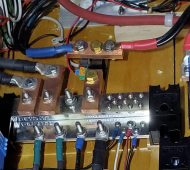RoadTurtle
Solar Enthusiast
- Joined
- Mar 30, 2022
- Messages
- 365
I'm nearing completion for the 12V system. !20V will take a bit longer. Hoping to {shudder} put a hole in the roof tomorrow, but think I have a plan for that. I bought 100' of red and black cable, but 25' may have been enough  Wire is pulled 1/2 way up the wall. Not totally happy with how things are coming together on the roof, but it is what it is.
Wire is pulled 1/2 way up the wall. Not totally happy with how things are coming together on the roof, but it is what it is.
Anyway, I need to bring down the solar wires, move two 100ah batteries from battery box to front compartment, clean things up a bit and connect the 12v wires to the trailer's "buss bar". Figuring to start the system while I work on the 120v runs.
Looking for good and bad comments on what I have done so far. I ordered the last wire from the fuse to the buss bar tonigh, also the networking cables. 712 will go in upper right corner, Cerbo display in the 5th wheel. Two completely independent strings of 600w. One string could go to 800w, the other string, but more challenging to increase. 400ah total battery, with room for 600ah. All 12v. Buss bars have a cover.

Anyway, I need to bring down the solar wires, move two 100ah batteries from battery box to front compartment, clean things up a bit and connect the 12v wires to the trailer's "buss bar". Figuring to start the system while I work on the 120v runs.
Looking for good and bad comments on what I have done so far. I ordered the last wire from the fuse to the buss bar tonigh, also the networking cables. 712 will go in upper right corner, Cerbo display in the 5th wheel. Two completely independent strings of 600w. One string could go to 800w, the other string, but more challenging to increase. 400ah total battery, with room for 600ah. All 12v. Buss bars have a cover.





